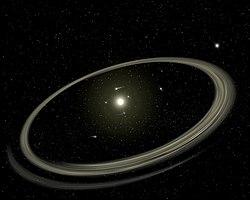Planetary system

A planetary system consists of the various non-stellar objects orbiting a star such as planets, dwarf planets, moons, asteroids, meteoroids, comets, and cosmic dust.[1][2] The Sun together with its planetary system, which includes Earth, is known as the Solar System.[3][4]
Origin and evolution

Planetary systems are generally believed to form as part of the same process which results in star formation. Some early theories involved another star passing extremely close to the Sun, drawing material out from it which then coalesced to form the planets. However, the probability of such a near collision is now known to be far too low to make this a viable model. Accepted theories today argue that a protoplanetary disk forms by gravitational collapse of a molecular cloud and then evolves into a planetary system by collisions and gravitational capture.[5]
Some planetary systems may form differently, however. Planets orbiting pulsars—stars which emit periodic bursts of electromagnetic radiation—have been discovered by the slight variations they cause in the timing of these bursts. Pulsars are formed in violent supernova explosions, and a normal planetary system could not possibly survive such a blast—planets would either evaporate, be pushed off of their orbits by the masses of gas from the exploding star, or the sudden loss of most of the mass of the central star would see them escape the gravitational hold of the star. One theory is that existing stellar companions were almost entirely evaporated by the supernova blast, leaving behind planet-sized bodies. Alternatively, planets may somehow form in the accretion disk surrounding pulsars.[6]
List of planetary systems


- Solar System – The Sun and its planetary system, the first such system discovered
- PSR B1257+12 – the first extrasolar planetary system discovered, the first pulsar planetary system discovered, the first multi exoplanet system discovered
- Upsilon Andromedae – the first multiplanet extrasolar planetary system discovered around a main sequence star, found to be so in April 1999
- PSR B1620-26 – the first multistar planetary system discovered.
- 55 Cancri – the largest extrasolar planetary system discovered (5 known planets as of November 6, 2007, along with a distant stellar companion.)[7]
- Gliese 876 – the first system around a red dwarf star and the first discovered to be in an orbital resonance
- HD 69830 – found to have three Neptune-mass planets and an asteroid belt, all within 1 AU[8][9]
- 2M1207 – the first imaged system and the first brown dwarf system with a planet discovered[10]
- Gliese 581 - first extrasolar system discovered with a super-Earth planet located within the habitable zone (Gliese 581 d)[11]
- Mu Arae - The system's innermost planet was the first "hot Neptune" to be discovered
- HD 188753 - The first triple star planetary system discovered
- HD 37124
- HD 12661
- HD 73526
- 47 Ursae Majoris
- Epsilon Eridani
- 14 Herculis
- UX Tau A
See also
References
- ^ p. 394, The Universal Book of Astronomy, from the Andromeda Galaxy to the Zone of Avoidance, David J. Dsrling, Hoboken, New Jersey: Wiley, 2004. ISBN 0471265691.
- ^ p. 314, Collins Dictionary of Astronomy, Valerie Illingworth, London: Collins, 2000. ISBN 0-00-710297-6.
- ^ p. 382, Collins Dictionary of Astronomy.
- ^ p. 420, A Dictionary of Astronomy, Ian Ridpath, Oxford, New York: Oxford University Press, 2003. ISBN 0-19-860513-7.
- ^ planetary systems, formation of, David Darling, entry in The Internet Encyclopedia of Science, accessed on line September 23, 2007.
- ^ Planet formation scenarios, Philipp Podsiadlowski, pp. 149–165, in Planets around pulsars; Proceedings of the Conference, California Inst. of Technology, Pasadena, Apr. 30-May 1, 1992, edited by J. A. Phillips, J. E. Thorsest, and S. R. Kulkarni, ASP Conference Series, 36, 1993.
- ^ Wired News (2002-06-13). "Found: Solar System Like Our Own".
- ^ Whitney Clavin (2005-04-20). "NASA's Spitzer Telescope Sees Signs of Alien Asteroid Belt".
- ^ Christophe Lovis (2006-05-18). "Trio of Neptunes and their Belt".
{{cite journal}}: Cite journal requires|journal=(help); Unknown parameter|coauthors=ignored (|author=suggested) (help) - ^ Robert Roy Britt (2004-09-10). "Likely First Photo of Planet Beyond the Solar System".
- ^ "Lightest exoplanet yet discovered". eso.org. 2009-04-21. Retrieved 2009-04-27.
- Stuart J. Weidenschilling & Francesco Marzari (1996). "Gravitational scattering as a possible origin for giant planets at small stellar distances". Nature. 384: 619–621. doi:10.1038/384619a0.

